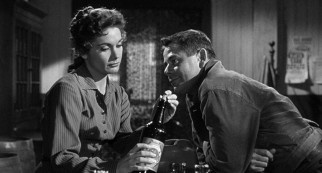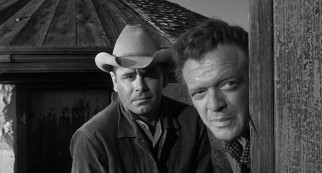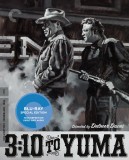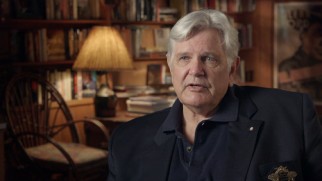3:10 to Yuma (1957): The Criterion Collection Blu-ray Review
 |
3:10 to Yuma
Theatrical Release: August 7, 1957 / Running Time: 92 Minutes / Rating: Not Rated Director: Delmer Daves / Writers: Halsted Welles (screenplay); Elmore Leonard (story) Cast: Glenn Ford (Ben Wade), Van Heflin (Dan Evans), Felicia Farr (Emmy), Leora Dana (Alice Evans), Henry Jones (Alex Potter), Richard Jaeckel (Charlie Prince), Robert Emhardt (Mr. Butterfield), Sheridan Comerate (Bob Moons), George Mitchell (Bartender), Robert Ellenstein (Ernie Collins), Ford Rainey (Bisbee Marshal); Uncredited: Barry Curtis (Matthew Evans), Jerry Hartleben (Mark Evans), Boyd Stockman (Bill Moons), Dorothy Adams (Mrs. Potter), Guy Teague (Orin Keene), Bill Hale (Dave Keene) |
Buy 3:10 to Yuma from Amazon.com: Criterion Blu-ray Criterion DVD Instant Video Sony DVD
Prevailing wisdom declares that the western hasn't been a commercially lucrative genre in nearly half a century. There are many box office casualties to support this claim, including high-profile flops like Jonah Hex and 2004's The Alamo. And yet, there have been some pretty compelling cases to the contrary in the recent efforts from esteemed directors who have often run into financial ceilings: the Coen Brothers landed the biggest hit of their careers with their 2010 True Grit remake It's premature to think that the western is back, even if Disney has spent $250 million on July's Jerry Bruckheimer-produced The Lone Ranger. Few studios would take such a gamble and these same recent years have given us costly underperformers like Cowboys & Aliens and The Assassination of Jesse James by the Coward Robert Ford. But any warming to the genre that long pervaded the motion picture business then fell out of favor can seemingly be traced back to the 2007 film 3:10 to Yuma. A remake of a 50-year-old film, that James Mangold-directed Russell Crowe, Christian Bale flick had two big factors working against it: an early September release date and the historically stunted Lionsgate as its distributor. Of greater concern than those details was it belonging to a genre that seemed old-fashioned and hadn't had a huge hit in a long time. 3:10 wasn't a huge hit and in fact it didn't even break even until home video and television sales (if even then), but its $54 million domestic gross on a $55 M production budget had to induce breaths of relief from its makers. What it also did was raise awareness of the film it remade.
That original western, 1957's 3:10 to Yuma, recently got another boost in its profile in the form of admission into The Criterion Collection. Last week, that "continuing series of important classic and contemporary films" revered by film lovers around the globe, treated this Columbia Pictures film to a new DVD and its first Blu-ray edition.
Set in the Arizona Territory in the 1880s, the film opens with Ben Wade (Glenn Ford) and his gang of twelve holding up a stagecoach and killing its driver. Cattle rancher Dan Evans (Van Heflin) and his two sons can only watch as the crime is committed, too helpless to do anything else. Wade's dozen ride into nearby Bisbee to report the robbery and murder to the marshal as the work of three men. As his gang moves on, Wade hangs back at the saloon to catch up with Emmy (Felicia Farr), a skinny, brown-eyed bartender he remembers from her days as a singer in another part of the country. Wise to the Wade gang's charade, law enforcement ambushes the leader and gets him in handcuffs. Anticipating retribution, the marshal and wealthy stage line owner Mr. Butterfield (Robert Emhardt) intend to ride Wade out of town, but this is no easy task.
When Butterfield offers $200 to anyone who will help, Dan volunteers. Struggling to provide for his family in the midst of a devastating drought, Dan can desperately use that money and is willing to do some dirty work. Joining him on the task is town drunk Alex Potter (Henry Jones), the film's henpecked comic relief. The plan calls for Dan and Wade to hole up in a Contention City hotel room to await the titular train and transport the killer to justice in federal prison.
The charming Wade is confident that his men will learn of his arrest and come to his rescue. Still, wanting to keep things easy and peaceful, he gives Dan an offer far richer than the owed $200 to let him go, all the way up to $10,000 to become the criminal's "silent partner." Dan listens and seems to entertain the idea, but one gets the sense that he places a tremendous value on righteous duty, even while being promised some much-needed financial comfort for him and his family.
This 3:10 to Yuma is fairly low on traditional western action, focusing instead on a battle of wits. Still, the anticipation of conflict hangs over the film as it builds and sustains a delicious atmosphere of tension. Wade and Dan offer a study of contrasts: the smooth outlaw bachelor who has stolen his way into comfort thoroughly differs from the stubborn, hard-working family man who finds himself crippled by a lack of rain. Their relationship isn't as cut-and-dry as lawman and crook Though one of the last westerns to eschew color photography, this film has aged very well. It's more sentimental and much less violent than the Peckinpah and Leone westerns to come. It can't resist getting a tad maudlin near its end, as it unrealistically brings Dan's wife (Leora Dana) to the center of the storm to try and convince her husband she'd rather not be the widow of a dead hero. Spelling out its apparent stakes is easily forgiven because it's sharp, taut, gripping theatre throughout that gets maximum mileage out of a compelling, unconventional premise.
That premise was first presented in "Three-Ten to Yuma", a short story in the March 1953 issue of Dime Western Magazine. The pulp tale was among the first published works of Elmore Leonard, an author of long prominence who would come to specialize in crime fiction including the novels that would be turned into Get Shorty, Out of Sight, Jackie Brown, and the FX drama series "Justified." Leonard's would appear to be the biggest name behind this film. Director Delmer Daves had a long career, but this is the best-regarded film he helmed, although his more numerous screenwriting credits include An Affair to Remember. Screenwriter Halsted Welles wrote almost entirely for television, penning episodes of programs like "Alfred Hitchcock Presents", "Kraft Suspense Theatre", and "Rod Serling's Night Gallery."
Of the cast, Ford's distinguished filmography stretches over fifty years, though he's not quite remembered as one of the really major movie stars of his time. Heflin appeared in films right up to his death in 1971, including Airport and a Stagecoach remake, but this and 1953's Shane remain what he is best known for. Felicia Farr, whose third billing seems an undeserved result of trying to emphasize a young female and potential rising star, picked up few theatrical credits beyond this, including Billy Wilder's Kiss Me, Stupid and a couple of 1970s Walter Matthau films.
Unsurprisingly since westerns were largely not taken seriously as cinema, 3:10 to Yuma picked up almost nothing in the way of accolades. It was one of sixteen films nominated for the BAFTA award for Best Film from Any Source. And it vied for a couple of action genre-specific honors in exhibitors' Laurel Awards. And yet, its enduring importance has been noted, most recently by last year's selection into the Library of Congress' National Film Registry.
VIDEO and AUDIO Somehow, 3:10 to Yuma's dazzling Blu-ray presentation even exceeds the high expectations for something carrying the Criterion name. The 1.85:1 picture is sharp and virtually spotless, clearly displaying every bead of glistening sweat and even the silhouetted response of Ben Wade's blinks. Rendering the film's 56 years imperceptible, this must be one of the best-looking 1080p transfers of a film this old. The spectacular video is equaled by the satisfying sound, which is offered in both uncompressed LPCM 1.0 mono (the default) and 5.1 DTS-HD master audio. I gave lengthy listens to each and have nothing poor to say of either one. The tasteful remix does not supply too much expansion, but when it does, it is to good effect. Furthermore, the recordings of dialogue and gunshots are gratefully crisp and perfectly intelligible. As always, Criterion kindly includes English subtitles too, but only on the film itself.
BONUS FEATURES, MENUS, PACKAGING and DESIGN Bonus features are the only area where this disc might be considered a minor letdown. That's because it includes just two supplements, each a new interview with someone connected to the film. First, we hear from author Elmore Leonard (13:01), who discusses the story he wrote for a pulp magazine and the two movies adapted from it, focusing more on the 1957 version.
Then, Peter Ford (15:04) discusses his father, actor Glenn Ford, whose definitive biography he wrote. Among the topics that arise: Glenn's love of the western genre, his other entries in it (a couple of which are nicely excerpted), his experiences with his co-stars, his Orson Welles-riling affair with Rita Hayworth, his paternal nature (or lack thereof), his social progressiveness, the role that young people know him best for (as Superman's adoptive father), and the curse of movie star offspring. Though they make for a fairly light Criterion release, those two new featurettes still offer a major improvement over Sony's 2007 Special Edition, whose only extras were the film's original theatrical trailer (this platter's most unfortunate exclusion) and a sneak peek of Lionsgate's then forthcoming remake. The simple menu plays a portion of Frankie Laine's opening and closing title song over a still of the two leads. Criterion remains the best studio at authoring Blu-rays, equipping this one with full resuming capability as well as the ability to place bookmarks on the film. 3:10 to Yuma is packaged in one of Criterion's standard clear keepcases of Blu-ray height and DVD width. It uses the reverse side to display chapter titles, but of course includes one of the company's usual, substantial insert booklets as well. Taking its front and back covers from the case's nice artistic rendering of original poster art, this one runs twenty pages and includes transfer information, cast and crew credits, and, of course, an essay. "Curious Distances" by author/documentarian Kent Jones celebrates the film in detail and heralds director Delmer Daves as an underappreciated auteur. Jones defends the film against criticisms it has received, holds it up in comparison to Howard Hawks' Rio Bravo, notes the departures from Leonard's original text, and even finds easily missed power in its visuals.
CLOSING THOUGHTS The original 3:10 to Yuma holds up better than the vast majority of American westerns, remaining a tense, gripping thriller without a wealth of style or action. Criterion's Blu-ray provides one of the all-time great restorations, making this 1957 film look new without betraying its original designs. Some will understandably be left wanting more in the way of bonus features and the omission of the original trailer is especially unfortunate, but the new interviews and essay booklet are nice company to the dynamite presentation of a great film. Support great cinema and this site when you buy 3:10 to Yuma now from Amazon.com:
|
Related Reviews:
DVDizzy.com | DVD and Blu-ray Reviews | New and Upcoming DVD & Blu-ray Schedule | Upcoming Cover Art | Search This Site
Westerns, Pre-1980: Stagecoach For a Few Dollars More Once Upon a Time in the West The Grand Duel & Keoma Hot Lead & Cold Feet
New: Shanghai Noon & Shanghai Knights The Man Who Shook the Hand of Vicente Fernαndez The Anderson Tapes & Physical Evidence
1950s on Criterion: On the Waterfront The Killing Paths of Glory A Night to Remember Kiss Me Deadly
Westerns, 1980s-Present: Heaven's Gate Tombstone Dead Man True Grit (2010) Rango Casa De Mi Padre
1950s: Hondo Old Yeller To Catch a Thief North by Northwest The Great Locomotive Chase
Glenn Ford: Gilda | Henry Jones: Arachnophobia The Grifters Deathtrap Napoleon and Samantha
Adapted from Elmore Leonard: Jackie Brown








